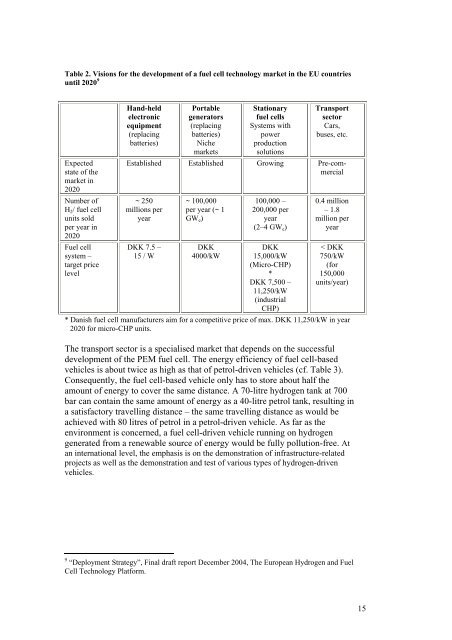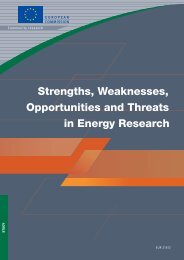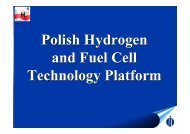Danish Strategy for Hydrogen and Fuel Cells - HY-CO Home
Danish Strategy for Hydrogen and Fuel Cells - HY-CO Home
Danish Strategy for Hydrogen and Fuel Cells - HY-CO Home
You also want an ePaper? Increase the reach of your titles
YUMPU automatically turns print PDFs into web optimized ePapers that Google loves.
Table 2. Visions <strong>for</strong> the development of a fuel cell technology market in the EU countries<br />
until 2020 9<br />
Expected<br />
state of the<br />
market in<br />
2020<br />
Number of<br />
H 2 / fuel cell<br />
units sold<br />
per year in<br />
2020<br />
<strong>Fuel</strong> cell<br />
system –<br />
target price<br />
level<br />
H<strong>and</strong>-held<br />
electronic<br />
equipment<br />
(replacing<br />
batteries)<br />
Portable<br />
generators<br />
(replacing<br />
batteries)<br />
Niche<br />
markets<br />
Stationary<br />
fuel cells<br />
Systems with<br />
power<br />
production<br />
solutions<br />
Transport<br />
sector<br />
Cars,<br />
buses, etc.<br />
Established Established Growing Pre-commercial<br />
~ 250<br />
millions per<br />
year<br />
DKK 7.5 –<br />
15 / W<br />
~ 100,000<br />
per year (~ 1<br />
GW e )<br />
DKK<br />
4000/kW<br />
100,000 –<br />
200,000 per<br />
year<br />
(2–4 GW e )<br />
DKK<br />
15,000/kW<br />
(Micro-CHP)<br />
*<br />
DKK 7,500 –<br />
11,250/kW<br />
(industrial<br />
CHP)<br />
0.4 million<br />
– 1.8<br />
million per<br />
year<br />
< DKK<br />
750/kW<br />
(<strong>for</strong><br />
150,000<br />
units/year)<br />
* <strong>Danish</strong> fuel cell manufacturers aim <strong>for</strong> a competitive price of max. DKK 11,250/kW in year<br />
2020 <strong>for</strong> micro-CHP units.<br />
The transport sector is a specialised market that depends on the successful<br />
development of the PEM fuel cell. The energy efficiency of fuel cell-based<br />
vehicles is about twice as high as that of petrol-driven vehicles (cf. Table 3).<br />
Consequently, the fuel cell-based vehicle only has to store about half the<br />
amount of energy to cover the same distance. A 70-litre hydrogen tank at 700<br />
bar can contain the same amount of energy as a 40-litre petrol tank, resulting in<br />
a satisfactory travelling distance – the same travelling distance as would be<br />
achieved with 80 litres of petrol in a petrol-driven vehicle. As far as the<br />
environment is concerned, a fuel cell-driven vehicle running on hydrogen<br />
generated from a renewable source of energy would be fully pollution-free. At<br />
an international level, the emphasis is on the demonstration of infrastructure-related<br />
projects as well as the demonstration <strong>and</strong> test of various types of hydrogen-driven<br />
vehicles.<br />
9 “Deployment <strong>Strategy</strong>”, Final draft report December 2004, The European <strong>Hydrogen</strong> <strong>and</strong> <strong>Fuel</strong><br />
Cell Technology Plat<strong>for</strong>m.<br />
15




